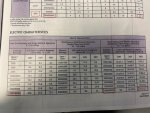Is appliance marked with minimum circuit or max overcurrent? If so go with whatever that says and it will comply with 422.11(E)(1)
Otherwise 422.11(E)(3) says: "Not exceed 150 percent of the appliance rated current if the overcurrent protection rating is not marked and the appliance is rated over 13.3 amperes. Where 150 percent of the appliance rating does not correspond to a standard overcurrent device ampere rating, the next higher standard rating shall be permitted"
Which is what lets us put typical 4500 watt 240 volt single phase water heaters on 30 amp breakers when otherwise they would be required to be on a 25 amp breaker. Thing that is different with your application though is you do have two conductors with load under 13.3 amps.
Reason you have this unbalance is it only has two elements connected in open delta configuration. Same appliance is likely intended to be connected to single phase supply by connecting the two elements parallel to one another, and in that case you would have 25 amps on each line and would require 31.25 amp conductors and 35 amp overcurrent protection - still supplying the same elements.
My guess is 30 amp three pole breaker is acceptable, if anything because max load on any one conductor of the circuit demands it, you still must use 30 amp conductor on those other two conductors though.


